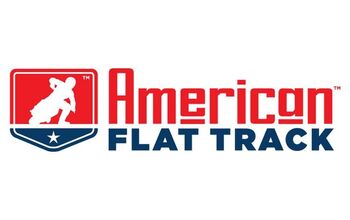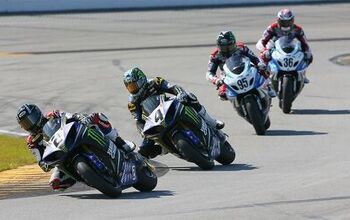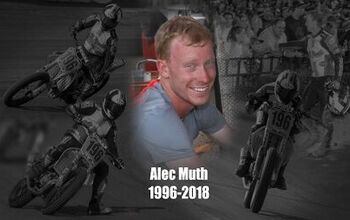The Future of the AMA and American Pro Motorcycle Racing
Rob Dingman: Redefining the AMA’s Future
Josh Hayes rode 69 nearly flawless laps to finish ahead of 68 other riders in the 2008 Daytona 200. Hayes and his team gave a dominating performance on the track but lost the race in their garage, getting disqualified for an illegal modification to the crankshaft in the Erion Honda CBR600RR. In the same event, five-time Daytona 200 winner Miguel Duhamel had scrapped his way from last to fourth place in 54 laps, only to see a black flag calling him back into the pits. He had been disqualified for switching motorcycles after the race’s opening lap. Two more incidents were added to a list of tarnishes that have happened at America’s premier motorcycle road race.
“Sanctioning racing is, even on its best day, controversial,” said American Motorcyclist Association CEO and president Rob Dingman before the start of the 200. “The AMA should never be associated with controversy, but our brand is mired in controversy.”
Dingman’s quote came a day after the AMA officially announced that it was selling its AMA Pro Racing properties to Daytona Motorsports Group (DMG). The sale signaled the beginning of a new future for the AMA.
“Our mission had become diluted,” Dingman stated. “We were trying to be all things to all people and we weren’t doing any one thing effectively. Our member benefits had suffered and we were looking for a way to alleviate this problem.”
In the press conference to announce the decision, DMG principle Roger Edmondson recalled how a similar move had been successful for the American Automobile Association (AAA). The AAA was a sanctioning body for American car racing until the 1955 Le Mans disaster. The following year it withdrew from racing to focus on legislative issues and member services. In the 50 years since this decision the organization has grown to nearly 50 million members with a powerful political presence. Dingman hopes the AMA can have a similar success story.
“There is a significant re-structuring of the organization going on, and racing is the most visible part of that,” he said. “We’re re-aligning resources and focusing on the thing that the AMA needs to exist for. We’re trying to create an environment where motorcycling is promoted. We need to significantly enhance our ability to be an advocacy organization, and racing overshadowed our primary mission.”
Dingman became AMA president in November 2006 and the organization’s CEO in March of 2007. His previous experience included serving as the AMA’s Washington D.C. representative, working as a government relations specialist for the Motorcycle Industry Council and a position as Assistant Commissioner for Transportation Safety for New York state. He quickly went to work, redefining the AMA’s mission and taking the organization in a new direction.
“For the first year we worked on putting a team together under the radar and working behind the scenes,” Dingman said. “Many things needed to be updated and made more professional.”
In September 2007 Dingman released a vision statement for the future of the AMA and announced that the association was “getting out of the racing promotions business and are already actively searching for series promoters for all race disciplines except for AMA Supercross.” In the same statement Dingman defined the AMA’s core mission as “the pursuit, promotion and protection of the future of motorcycling.” Dingman delineated what he feels are the biggest issues that should be on the AMA’s table.
“When I was being interviewed for the CEO position by the board they asked me what were the three most significant issues facing motorcycling today. I told them ‘sound, sound and sound,’” he recalled. “Most of the challenges facing motorcycling today, whether it’s land closures or being excluded from HOV lanes, neighborhoods or gated communities have to do with sound. It’s an issue that needs to be addressed and we need to keep the sound levels down.”
The past few years have been tumultuous for the AMA, with employees retiring, resigning or being fired, angry letters of protest, criminal investigations (in February of this year it was announced that former board chairman and Hall of Famer Dal Smilie was being investigated for unsubstantiated travel expense reimbursements) and rampant rumors on the Internet about power struggles and coup attempts within the AMA organization. But Dingman hopes that the transitional pains are behind the organization. The AMA Board of Directors publicly supports his leadership and he hopes that his tenure will bring stability to the organization.
“For the first time in a long time the AMA CEO and the board are working arm in arm,” he noted. “Change is never easy, but we’re very optimistic. There are significant changes and improvements still ahead. The future is bright.”
Along with increased government advocacy, other improvements that Dingman has proposed include enhanced member benefits and an improved AMA magazine, American Motorcyclist. He also hopes to increase the AMA’s membership, which has not matched the growth in the motorcycle industry over the last decade.
“The AMA has nearly 300,000 members and we need to start telling those member’s stories,” Dingman said. “The average motorcyclist really doesn’t know about the AMA. Everyone should know about it and a large percentage of those who know about us should be members.”
When asked where he hopes the AMA will be in 10 years, Dingman responds with this vision:
“I’d like to see a resurgence in the AMA brand. I’d like the AMA to be identified with everything that is cool in motorcycling. I’d like for us to be a larger organization with more clout so that motorcycling doesn’t face adverse reactions.”
For more on Rob Dingman’s vision for the AMA, see his December 2007 statement.
Roger Edmondson: Helping American Motorcycle Racing Reach Its Potential
“Irony” is the word that Roger Edmondson uses to describe his place at the helm of professional motorcycle racing in the U.S. as a principle member of Daytona Motorsports Group, a business that recently acquired AMA Pro Racing and the series it manages. It was only recently that Edmondson, who has spent his life being involved with two-wheeled competition, was a pariah in the motorcycle racing world.
“It was tough walking around a race track and being invisible, to walk by old friends and have them not speak to you because they were afraid of being associated with you,” Edmondson recalled.
Edmondson founded the Championship Cup Series (CCS) in 1984 which rapidly grew into a successful racing program. He combined forces with the AMA in 1986 to form the AMA Pro-Am Championship Series and spent nearly the next decade as the organization’s road race manager, a period that some point to as the best in AMA racing history. But by the early ’90s the relationship between Edmondson and the AMA began to sour and the two parties sought to part company.
But dividing their joint racing venture was no easy task and the conflict led to a protracted legal battle. Edmonson went on to form the North American Sport Bike Series, but interference and conflict from AMA racing hampered the series’ progress. After a jury sided with Edmondson but didn’t specify damages (said to be about $3 million –Ed.), he settled with the AMA out of court.
“We won and had the court’s stamp of approval, but by this point I was ruined financially with all the legal fees,” Edmondson noted.
Edmondson moved on, switched from two wheels to four and helped organize the Grand-American prototype car series with the backing of NASCAR legend Jim France. His Midas touch also applied to cars and the series has enjoyed unparalleled success. In 2006, he returned to motorcycle racing, founding the Moto-ST series, a team endurance racing program that used spec tires and spec fuel (for more on Edmondson and the Moto-ST series, see the link at the end of this article).
In September of 2007 AMA president and CEO Rob Dingman announced that the organization was looking for professional partners to promote its racing series. In response Edmondson and France formed Daytona Motorsports Group, with their initial intent to bid on the AMA road racing contract. Their proposal grew to include all forms of AMA sanctioned racing (except Supercross, which has a separate deal with Live Nation –Ed.) and won the AMA’s approval.
“Their proposal surprised us,” Dingman said of DMG. “We were honored that they were interested. The France family has a history with the AMA. We recognize the value of France and Edmondson’s association with the AMA. It puts the racing in the hands of capable individuals.”
“I was pleased and humbled. It was a great honor,” Edmondson said of the acceptance of the DMG proposal. “Jim France and I have a reputation for integrity. This is a new era, with a new sheriff.”
But Dingman and the AMA saw the need for more than a simple announcement of Daytona Motorsports Group’s winning proposal. They used the opportunity to apologize to a man that has meant so much to American motorcycle racing.
“It was very important to make a public apology, because the Edmondson family had been wronged by the AMA. The legal system had already agreed with that,” Dingman said. “The AMA had a well-documented pattern of unethical and bad business practices. It’s not going to be that way going forward. The new leadership recognized that and we chose to address those questions head-on.”
“It was unexpected and emotional,” Edmondson said of the apology. “It put the frosting on what was already a really nice cake.”
The 2008 AMA season will be a transitional one, as DMG takes over the reins for AMA racing. There are few concrete details at this time about what changes the future may hold, but Edmondson was willing to talk in generalities until DMG has made further plans.
“We need to start off by doing triage, focusing on the forms of racing that are hurt the most and try to save them,” he said. “Flat-track racing comes to mind as a series that has a lot of potential but has been hurting over the past years.”
DMG will keep the AMA name and they will also seek to partner with other promoters for specific series, in an arrangement similar to what the AMA currently has with Live Nation and the Supercross series.
“Supercross and Arenacross are in the hands of good people,” Edmondson said of the Live Nation contract. “Our expertise is not selling tickets, but we need to give the promoters that we partner with a product to sell. We will wholesale our races to a promoter who retails it to the ticket sellers.”
Though the details are uncertain, Edmondson’s philosophy of motorcycle racing is not.
“There should be racing where every team legitimately has the opportunity to win,” he said. “We need to gear the series towards teams and make the classes distinctly different.”
“The races should be determined by the riders on the racetrack, not by the tires,” he added. “If a certain part is allowed, it should be within the budget of most of the teams. If Michael Jordan can’t afford it, then there’s a problem. AMA racing is not the end of the world. It’s a national championship and it needs to be treated that way.”
Series run on spec-tires and spec-fuel are a possibility, with stricter regulations meaning for closer races, but don’t expect a NASCAR-like field of entrants.
“There will not be a “Motorcycle of Tomorrow,” Edmondson said in reference to the NASCAR vehicles that are nearly spec across the board. “The racing will be based on production machines.”
Edmondson also has big plans for the Daytona Bike Week events that kick off the AMA season, including America’s premier motorcycle race, the Daytona 200.
“We need to rearrange the weekend and move Supercross to Saturday,” he said. “The 200 should be run under the lights on Friday night and run on the big track. In 2009 Superbikes will again be in the 200, but Superbikes may not be the same as they are now. It’s something that we need to be sure can be done safely.”
For Edmondson, it’s all part of a vision to make American motorcycle racing more professional, more popular and more inclusive.
“We need to have Fortune 500 companies get behind motorcycle racing as a place to have their products represented,” Edmondson said. “The sport should mature into a place where professional teams put on a good show. Hopefully we’ll be planting the seeds that will be harvested by the next generation.”
Related Reading
AMA sells Pro Racing
AMA Continues Restructuring
Moto-ST: Bringing Twins Back to the Track
More by Jeremiah Knupp



























Comments
Join the conversation